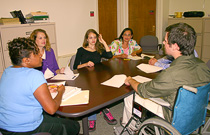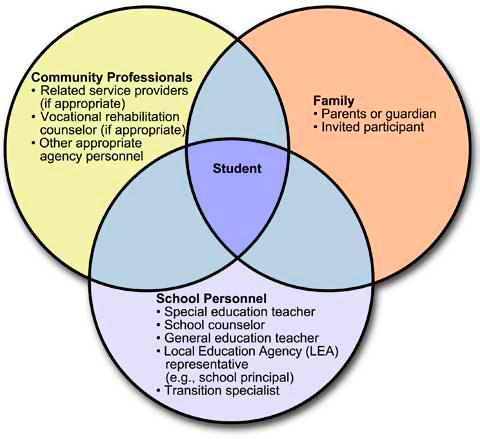What is the transition planning process for students with disabilities?
Page 3: Transition Planning
 Transition planning is federally required for all students who have an IEP. Transition planning should begin with the first IEP that is in effect when the student turns 16, or younger if determined to be necessary by the IEP team. In order for students to achieve their measurable post-school goals, the IEP must include a description of the transition services needed to help the student move from high school into the adult world. The transition services section of the IEP is a long-term individualized plan that addresses future goals at a minimum in the three areas required by IDEA 2004: education/ training, employment, and independent living. Click here to review a sample transition services section of an IEP (PDF).
Transition planning is federally required for all students who have an IEP. Transition planning should begin with the first IEP that is in effect when the student turns 16, or younger if determined to be necessary by the IEP team. In order for students to achieve their measurable post-school goals, the IEP must include a description of the transition services needed to help the student move from high school into the adult world. The transition services section of the IEP is a long-term individualized plan that addresses future goals at a minimum in the three areas required by IDEA 2004: education/ training, employment, and independent living. Click here to review a sample transition services section of an IEP (PDF).
Keep in Mind
School counselors should be aware of these guiding principles of the transition planning process.
|
|
Start early
Coverage of topics that are tied to adult-outcome areas can begin, for most areas, at the elementary level and certainly should begin before the mandated transition activities occur at age 16. Such coverage can occur through curricular design and instruction. Specifically, this principle suggests that the precursors of the knowledge and skills needed in adulthood can be addressed early in a student’s school career. Addressing these topics early increases the richness of the formal transition activities that will occur later.
Be comprehensive
Transition planning must include a range of transition planning domains (adult-outcome areas). Comprehensive planning includes both adequate assessment and actual goal generation. In addition, a comprehensive look at the transition needs of all students with IEPs should occur. It is a serious oversight to assume that certain students may not have needs in key adult-outcome areas.
Base on student
Transition planning must be student driven; that is, it must be based on a student’s strengths, interests, preferences, goals, and needs (including disability-related needs), not only because the law requires it but also because the student should be the key decision maker in matters pertaining to his or her own future life. The key terms used in this principle and found in law and literature are defined below.
- Strengths: Specific competencies needed to deal successfully with the demands of adulthood, in personal and job-related settings, that an individual regularly demonstrates at high rates of proficiency
- Interests: What a person is curious about, likes to spend time doing, or sees as a potential benefit
(Clark, 2007) - Preference: Related to an individual’s values and based on informed personal choices among interest-related options
(Clark, 2007) - Needs: Specific competencies needed to deal successfully with the demands of adulthood, in personal and job-related settings, that an individual does not regularly display at levels of proficiency
Use assessments
Appropriate formal and informal assessment of a student’s strengths, interests, preferences, and needs must be conducted. Assessment should address the three major transition planning domains and should be sensitive to the student’s age, disability, and cultural background. Such considerations allow school personnel to acquire accurate and valid information about the student.
Identify goals
Assessment results can help the student and IEP team identify major post-secondary goals in the three areas identified by IDEA 2004:
- Education/ training
- Employment
- Independent living (if applicable)
Require student participation
Because it is his or her life that is being considered, the student must be an active member of the IEP team and must contribute to the transition process. In some cases, the student may need to be taught explicitly how to be an active participant. It should be noted that a few students with IEPs, given their significant challenges, will not be able to participate as fully as other students; however, some measure of participation is achievable in most situations.
Request family involvement
Families will continue to play a key role in the post-school lives of their young adult-aged children. It is crucial that school personnel empower families by providing them with information and by involving them as important members of the transition team. This is especially crucial for the families of students who will not qualify for services when school is completed. In these cases, the families become the “service coordinators” in these students’ lives.
Observe cultural sensitivity
The transition process must be sensitive to and respectful of the cultural contexts from which students and their families come and of the family values that are manifested through interests and preferences.
Consider deadlines
It is important to perform certain activities in a timely fashion so that the student is able to access whatever services and supports he or she will need when school ends. For instance, some services (e.g., supported living arrangements) may have a waiting list; as a result, getting one’s name on this list as soon as possible is critical.
Coordinate agencies
The transition process requires that school personnel establish relationships with agencies, organizations, and educational institutions in the adult sector. These relationships involve, at a minimum, sharing information through communication and, ideally, establishing effective collaborative associations. School counselors typically have done this well with individuals at settings such as colleges and work-related agencies. However, contact and relationship building with other agencies, such as the Social Security Administration, may also be necessary.
The IEP Team
The transition planning section of the IEP describes the coordinated set of activities that need to take place in order for students to attain their post-secondary goals. These activities are developed and carried out by a team, typically consisting of the student and his or her family, school personnel, and community professionals.
| Team Member | Roles |
| Student |
|
| Parents or guardians |
|
| Special education teacher |
|
| General education teacher |
|
| School counselor |
|
| Transition specialist (when available) |
|
| Related service providers (if appropriate) |
|
| LEA representative (e.g., the principal) |
|
| Vocational rehabilitation counselor (if available) |
|
| Other agency personnel (as indicated) |
|

This is a three-circle Venn diagram detailing the IEP team members. The three circles are Community Professionals, Family, and School Personnel, all intersecting in the middle for the Student. Under Community Professionals the following is listed: related service providers (if appropriate), vocational rehabilitation counselor (if appropriate), and other appropriate agency personnel. Under Family the following is listed: parents or guardian, and invited participant. Under School Personnel the following is listed: special education teacher, school counselor, general education teacher, Local Education Agency (LEA) representative (e.g., school principal), and transition specialist.
Listen to Ed O’Leary discuss the importance of creating a coordinated transition plan (time: 1:37).

Ed O’Leary, PhD
Program Specialist, Transitions Outcomes Project
Mountain Plains Regional Resource Center
Utah State University, Logan, Utah
Transcript: Ed O’Leary, PhD
The coordinated set of activities I like to refer to as the “big picture plan for adult life” addresses the areas of instruction and related services, community experiences, employment, daily living, etc. The idea behind this particular requirement is to develop a long-range, coordinated plan that identifies all of the steps that need to be taken to help that young person achieve their measurable post-secondary goal. We’re spelling out all of the things that need to happen, the school year in which they need to occur, who will have primary responsibility for that particular action or step, and who’s going to actually provide that and pay for it. The idea is a coordinated plan between schools and families and students and the appropriate agency or agencies. The reality is that schools alone cannot develop or put into place this type of big picture, long-reach plan by themselves. It’s going to take the involvement of the family. It’s going to take the involvement of the student having some responsibility for those things that they need to do in order to achieve their measurable post-secondary goals, as well as the identification and the specification of what it is other agencies are going to do. So it is truly a coordinated plan then between all of the various parties.
Transition Update - Developing Sandra's Transition Plan
 Sandra is in the beginning stages of the transition process. She recently met with Mr. Hunter to create measurable post-secondary goals. Soon, the IEP team will meet to discuss Sandra’s current levels of performance and work its way through the rest of the process shown in the figure below. It is important to note that the IEP team will repeat this process each year, revisiting and revising information and the transition services section of the IEP as needed and writing new annual goals.
Sandra is in the beginning stages of the transition process. She recently met with Mr. Hunter to create measurable post-secondary goals. Soon, the IEP team will meet to discuss Sandra’s current levels of performance and work its way through the rest of the process shown in the figure below. It is important to note that the IEP team will repeat this process each year, revisiting and revising information and the transition services section of the IEP as needed and writing new annual goals.

Adapted from O’Leary, 2005.